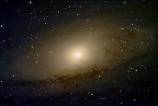 2010/M31, jpeg, 176k
2010/M31, jpeg, 176kGalaxies come as singles, more often in groups or dense clusters of thousands, some collide and disrupt each other to peculiar shapes, some explode and many are interesting to us because of their mere beauty. Many questions concerning their formation and evolution, their morphology and social behavior are far from being well understood.
All kinds, from the very faint dwarf types, the low-surface-brightness open spirals, some of them are the largest galaxies in the universe, up to the extremely massive, giant ellipticals, which govern the cores of rich clusters, all are within the reach of modern amateur equipment. (Classification of galaxies) Even under urban conditions many details like dust lanes, HII-regions, giant star clouds, ... can be brought to visibility with the help of CCD cameras and digital image processing. Even extra-galactic globular clusters, jets, novae and supernovae are no serious problems for todays equipment.
This is the famous Andromeda Galaxy. For more Information see my special page about M31
Image data: 12 images of 45 seconds integration time were combined. Canon 50d, sRAW, ISO 1600, 12" Newton, F/6, Paracorr, 2010/10/10.
NGC185, Companion of M31. Note the dusty patches.M33, another spiral neighbour.
Image data: 8 images of 120 seconds integration time were combined. Canon 50d, sRAW, ISO 1600, 12" Newton, F/6, Paracorr, 2010/10/11.
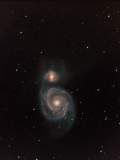 M51, jpeg, 80k
Colliding spiral galaxies in Ursa Major, 10"Newtonian f/4.6, ST8E, 04/24/03
M51, jpeg, 80k
Colliding spiral galaxies in Ursa Major, 10"Newtonian f/4.6, ST8E, 04/24/03
LRGB-filtered image sets with RGB-ratios 1:1:1.6. DDP-processed
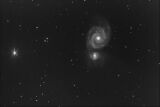 M51, Colliding spiral galaxies in Ursa
Major, 10" f/4.6, ST8E, 04/24/03, small jpeg, 7k and a large jpeg, 57k
M51, Colliding spiral galaxies in Ursa
Major, 10" f/4.6, ST8E, 04/24/03, small jpeg, 7k and a large jpeg, 57k
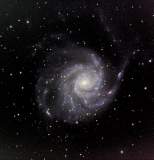 M101, jpeg, 60k
Spiral galaxy in Ursa Major, 10"Newtonian f/4.6, ST8E, 04/24/03
M101, jpeg, 60k
Spiral galaxy in Ursa Major, 10"Newtonian f/4.6, ST8E, 04/24/03
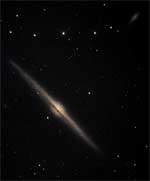 NGC4565,
Edge-on galaxy in Coma, 10" f/4.6, ST8E, 04/24/03 large jpeg 144k
NGC4565,
Edge-on galaxy in Coma, 10" f/4.6, ST8E, 04/24/03 large jpeg 144k
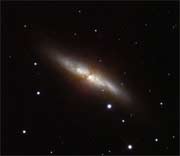 M82, starburst galaxy in Uma, 10" f/4.6, ST8E, 04/24/03
large jpeg 154k
M82, starburst galaxy in Uma, 10" f/4.6, ST8E, 04/24/03
large jpeg 154k
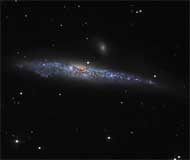 NGC4631, Edge-on galaxy in Coma, 10" f/4.6, ST8E, 04/25/03
large jpeg 94k
NGC4631, Edge-on galaxy in Coma, 10" f/4.6, ST8E, 04/25/03
large jpeg 94k
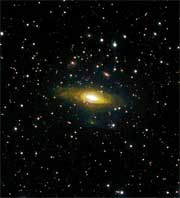 NGC7331 and Stepan's Quintet in Peg, 5"
f/5 FH-Refractor, ST8E, 04/25/03 large jpeg 250k
NGC7331 and Stepan's Quintet in Peg, 5"
f/5 FH-Refractor, ST8E, 04/25/03 large jpeg 250k
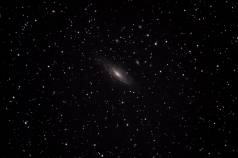 Spiral galaxy NGC7331 in Peg,
jpeg, 212k
Spiral galaxy NGC7331 in Peg,
jpeg, 212k
Image data: 44 images of 45 seconds integration time were combined. Canon 50d, sRAW, ISO 1600, 12" Newton, F/6, Paracorr, 2010/10/10.
NGC925, large spiral galaxy in Triangulum.
NGC1023, barred spiral galaxy in Perseus.
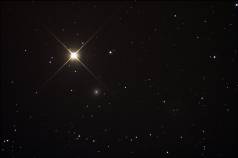 Small elliptical alaxy NGC404 in And,
jpeg, 392k The bright star is beta And.
Small elliptical alaxy NGC404 in And,
jpeg, 392k The bright star is beta And.
Image data: 4 images of 120 seconds integration time were combined. Canon 50d, sRAW, ISO 1600, 12" Newton, F/6, Paracorr, 2010/10/10.
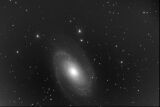 M81, Spiral galaxy in Ursa
Major, 10" f/4.6, ST8E, 02/24/03, small jpeg, 9k and a large jpeg, 44k
M81, Spiral galaxy in Ursa
Major, 10" f/4.6, ST8E, 02/24/03, small jpeg, 9k and a large jpeg, 44kThree self-guided images of 200 seconds integration time were used.
The following 2 images are among the first I obtained with my self-build
Cookbook camera.
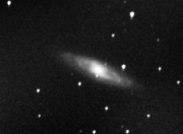 Spiral galaxy M65 in Leo, 2x zoomed, jpeg, 5k
Spiral galaxy M65 in Leo, 2x zoomed, jpeg, 5k
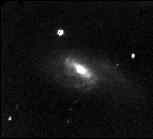 Barred spiral galaxy M66 in Leo, 2 x zoomed detail,
jpeg, 10k
Barred spiral galaxy M66 in Leo, 2 x zoomed detail,
jpeg, 10k
Not only on my homepage, but also in the heaven these two galaxies are closely related. Together with NGC 3628 they form Leo's triplet.
Two problems bothered me when the images were made. First, several street lights which are covered by trees during summer, are lighting my observation place and caused the steep background gradient in the images that was hard to remove. Second, cooling was something around 0 deg Celsius, because problems with condensations and ice prevented a better performance of the system.
In the night of April 23, I had several problems in a first test, far from home and normal electricity. The following image of NGC 4565 is a raw image of 120 second exp. time, without further processing. The bright core, over-exposed in most images, stands out clearly. The dust lanes are also well visible. The image should be compared to my drawing from the same galaxy, from 1997.
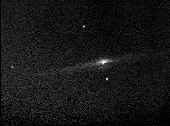 Edge-on galaxy NGC 4565 in Coma berenices, 04/23/98,
jpeg, 14k
Edge-on galaxy NGC 4565 in Coma berenices, 04/23/98,
jpeg, 14k
Two images from May 19. Both were made from 22 integrations of 70 seconds duration. Six dark fields of 210 seconds integration time were used to remove the dark current. No other processing than some scaling was used. During the integration of the images a sky-beamer form a near circus threatened this enterprise.
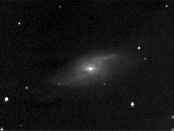 M106 Galaxy in Canes Venatici, jpeg, 18k
M106 Galaxy in Canes Venatici, jpeg, 18k
 M106, zoomed, and sharpened with Max. Ent. Deconvolution,
jpeg, 23k
M106, zoomed, and sharpened with Max. Ent. Deconvolution,
jpeg, 23k
Compare with images of other origin.
The next image is from July 19. After two month of rain and cloudy nights,
we had
some hours of a clear summer sky. The image of M102 is a single shot of 60
second integration time. Three darks of 120 seconds and a flat field (average
of
7 images) were used.
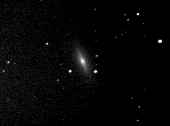 M102 = NGC 5866, Edge-on galaxy in Draco, jpeg,
19k
M102 = NGC 5866, Edge-on galaxy in Draco, jpeg,
19k
The following images are from July 30. Good, clear summer sky. The images of NGC 7479, 7814, 7385 are single shots of 100 second integration time. All others were made with 1 min exp.time. Five darks of 120 seconds and a flat field (average of 7 images) were used in all cases.
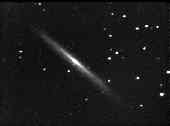 NGC 5907, Edge-on galaxy in Draco, jpeg, 25k
NGC 5907, Edge-on galaxy in Draco, jpeg, 25k
NGC 5866 and 5907 are the chief members of a group of galaxies in Draco. Thankīs
to Dr.Guenter Beyer, who frequently supports the German astro mailing list
with interesting astronomical news, I now know, that NGC 5907 has a quite
unusual stellar halo population. "Unlike the halo of normal stars surrounding
many spiral galaxies, which drops off very quickly away from the center,
this halo dropped off more slowly -- at about the rate predicted for the
mysterious dark matter. Dark matter, composed of either normal or
exotic material, must fill the galaxy in order to explain why stars rotating
around the center havenīt flown away... ".
(Click here to read the complete text).
This is a quite interesting galaxy as the following collection of abstracts shows.
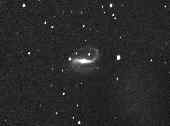 NGC 7479, Barred spiral galaxy in Pegasus, jpeg,
32k
NGC 7479, Barred spiral galaxy in Pegasus, jpeg,
32k
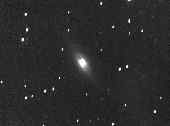 NGC 7814, Edge-on galaxy in Pegasus, jpeg, 25k
NGC 7814, Edge-on galaxy in Pegasus, jpeg, 25k
The following images are from August 19, 1998.
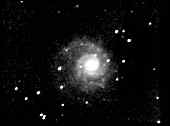 M74, Low surface brightness spiral galaxy in Pisces,
jpeg, 23k
M74, Low surface brightness spiral galaxy in Pisces,
jpeg, 23k
Don't miss my drawing of this galaxy.
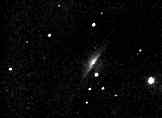 NGC 1055 ,Edge-on galaxy in Cetus , jpeg, 25k
NGC 1055 ,Edge-on galaxy in Cetus , jpeg, 25k
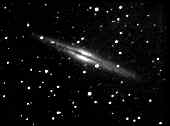 NGC 891 ,Edge-on galaxy in Andromeda , jpeg, 23k
NGC 891 ,Edge-on galaxy in Andromeda , jpeg, 23k
The next image is one of the first I obtained with my new SBIG ST8E.
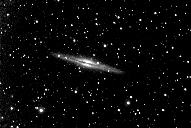 NGC 891, CG11 f/6.3, 12/05/99, jpeg, 49k
NGC 891, CG11 f/6.3, 12/05/99, jpeg, 49k
The following images are from December 17, 1998.
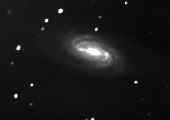 NGC 2903, Large barred spiral in Leo, 12/17/98,
jpeg, 20k
NGC 2903, Large barred spiral in Leo, 12/17/98,
jpeg, 20k
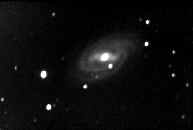 M109, Large barred spiral in UMa, 12/17/98,
jpeg, 11k
M109, Large barred spiral in UMa, 12/17/98,
jpeg, 11k
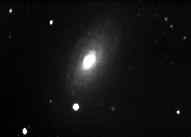 M63 ,Large spiral in Canes Venatici, 12/17/98,
jpeg, 7k
M63 ,Large spiral in Canes Venatici, 12/17/98,
jpeg, 7k
The image below is from March 11, 1999. It shows the very special case, where a galaxy and a quasar have a very small angular distance to each other. This fact has been used to measure the amount of invisible dark matter in the halo of this galaxy by spectroscopic means. It was found that there is 20 times more dark material than that visible in stars and gas clouds. (Read also the notes about NGC 5907 above).
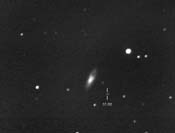 NGC 3067 and quasar 3C 232 in Leo Minor,03/11/99,
jpeg, 20k
NGC 3067 and quasar 3C 232 in Leo Minor,03/11/99,
jpeg, 20k
Collection of abstracts about this pair.
The images below are from May 16, 1999.
The Sombrero Galaxy is a composition of 6 single frames, the exp. time was 45 seconds, telescope was my new 8" Newtonian f/4.6. M104 was the first galaxy were a "red shift" was detected, years before the true nature of galaxies was known. The red shift of the lines in spectra of almost all galaxies indicates the expansion of the universe. M104 has a large system of globular clusters.
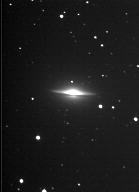 M104,Sombrero galaxy, Edge-on galaxy in Virgo, 8"
f/4.6,05/16/99,jpeg, 16k
M104,Sombrero galaxy, Edge-on galaxy in Virgo, 8"
f/4.6,05/16/99,jpeg, 16k
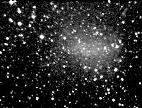 NGC 6822, Dwarf galaxy in Sagittarius, 8"
f/4.6, 05/16/99, jpeg 28k
NGC 6822, Dwarf galaxy in Sagittarius, 8"
f/4.6, 05/16/99, jpeg 28k
Faint dwarf galaxy hiding behind the Sagittarius summer sky Milky Way.
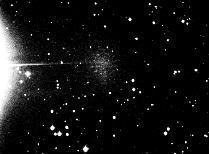 Leo I, Dwarf galaxy in Leo, 8" f/4.6, 01/28/00,
jpeg 27k
Leo I, Dwarf galaxy in Leo, 8" f/4.6, 01/28/00,
jpeg 27k
The bright star on the left side is Regulus, less then half degree to the
south.
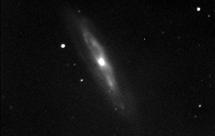 M98, Spiral in Virgo, C11 f/10, 04/06/00, jpeg 9k
M98, Spiral in Virgo, C11 f/10, 04/06/00, jpeg 9k
These three Virgo spirals are close together in the western part of the constellation. The distance from Earth is something like 56 million light-years in the case of M100 and the others should be comparable. Due to the long focal length of 2800mm I could not manage to find a usable guide-star for my self-tracking ST8. So all images are super positions from series of short exposures (6 images of 45 seconds each for M100 and M99, 16 images of 25 seconds for M98, 3x3 binning). Darks and bias images were also used.
More images of galaxies can be found on my pages about
